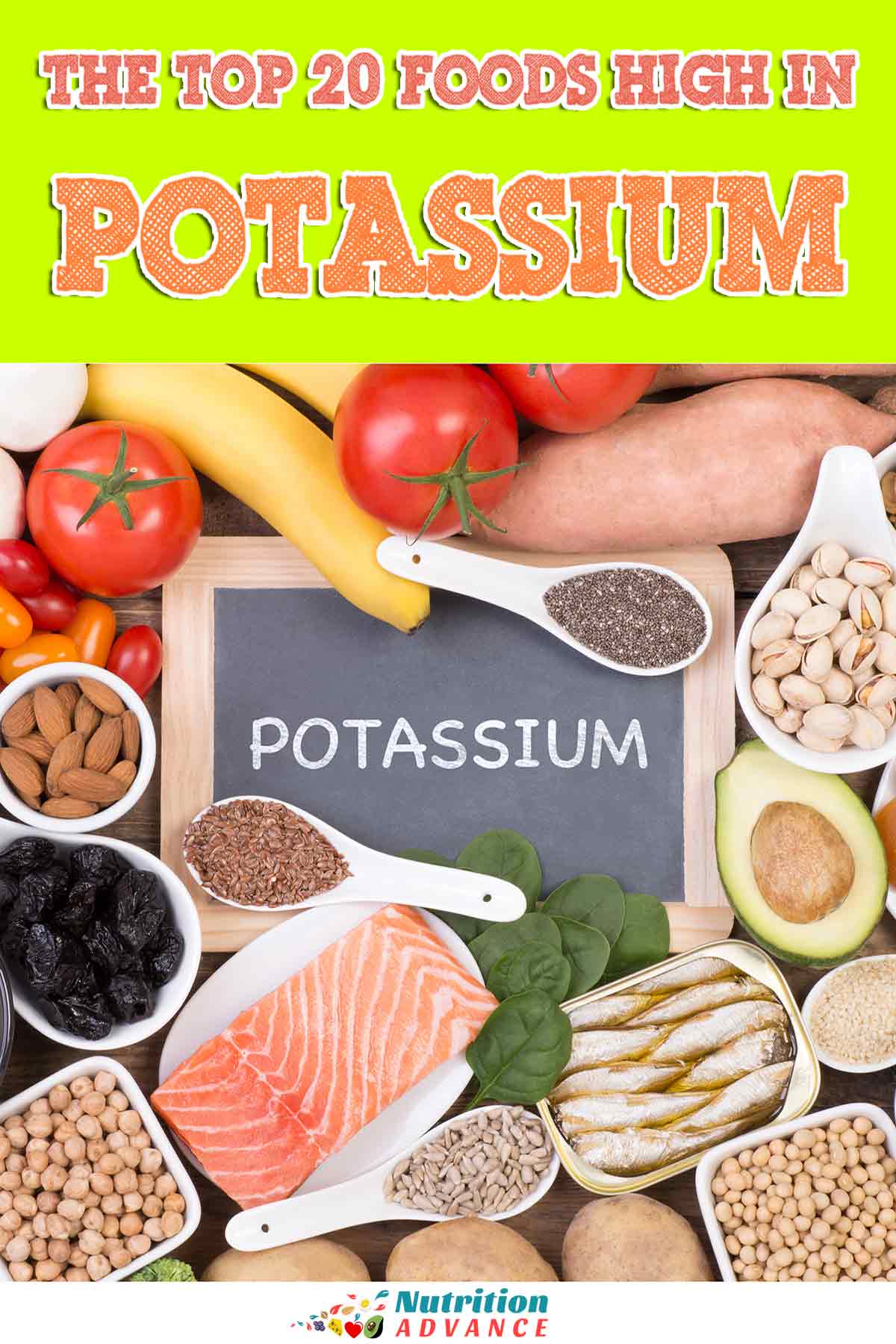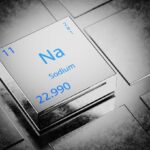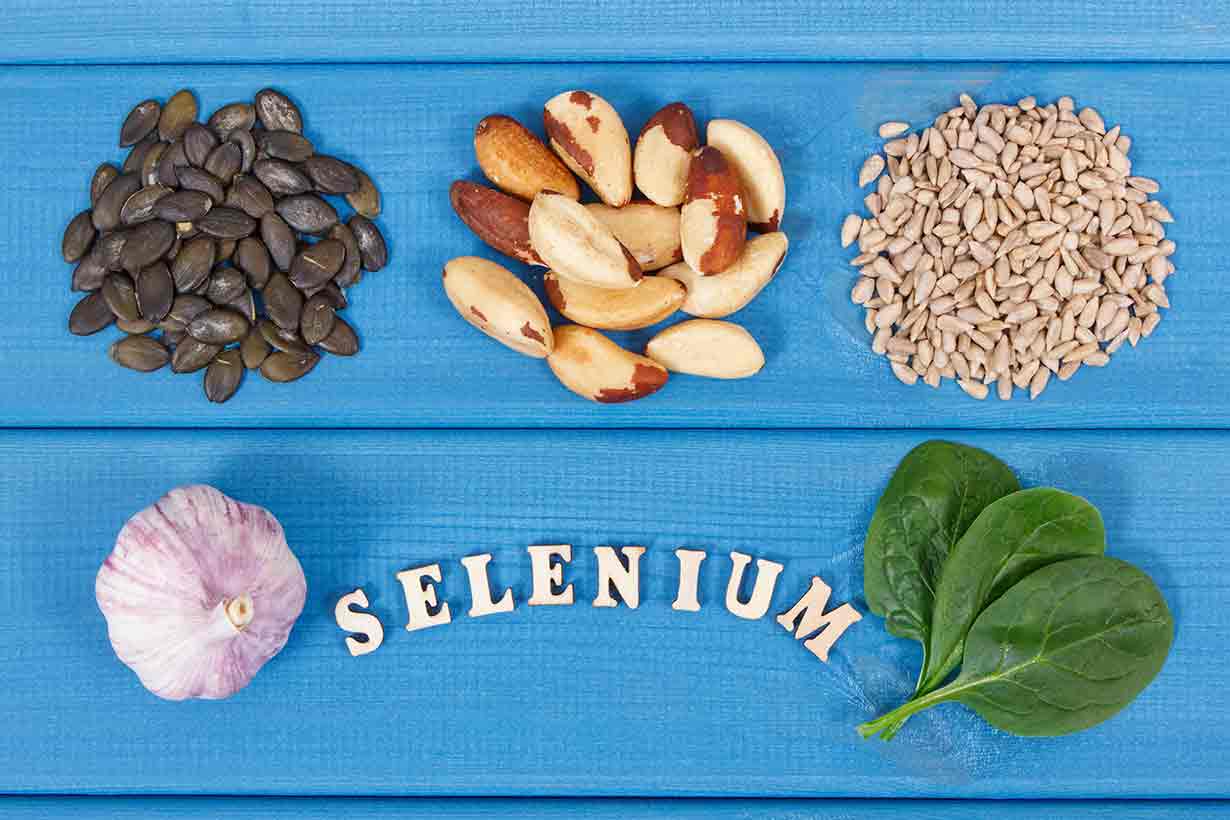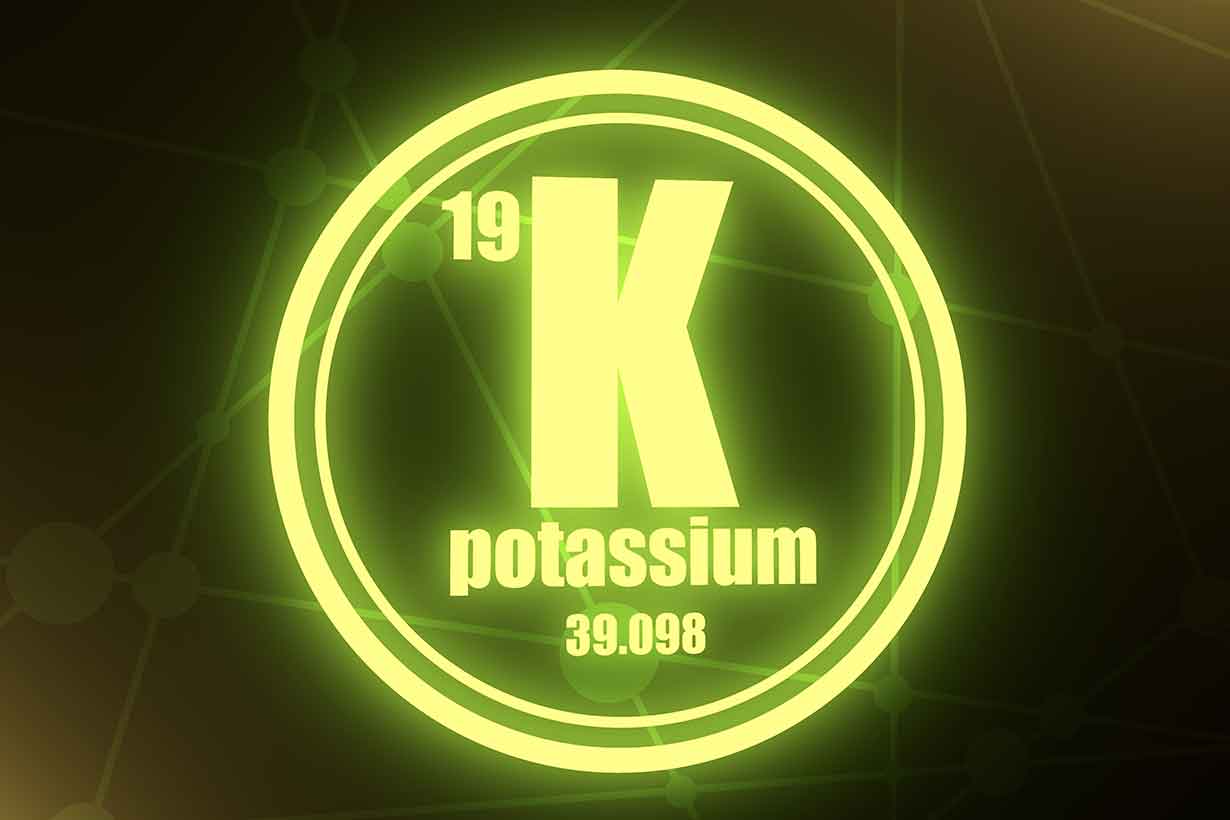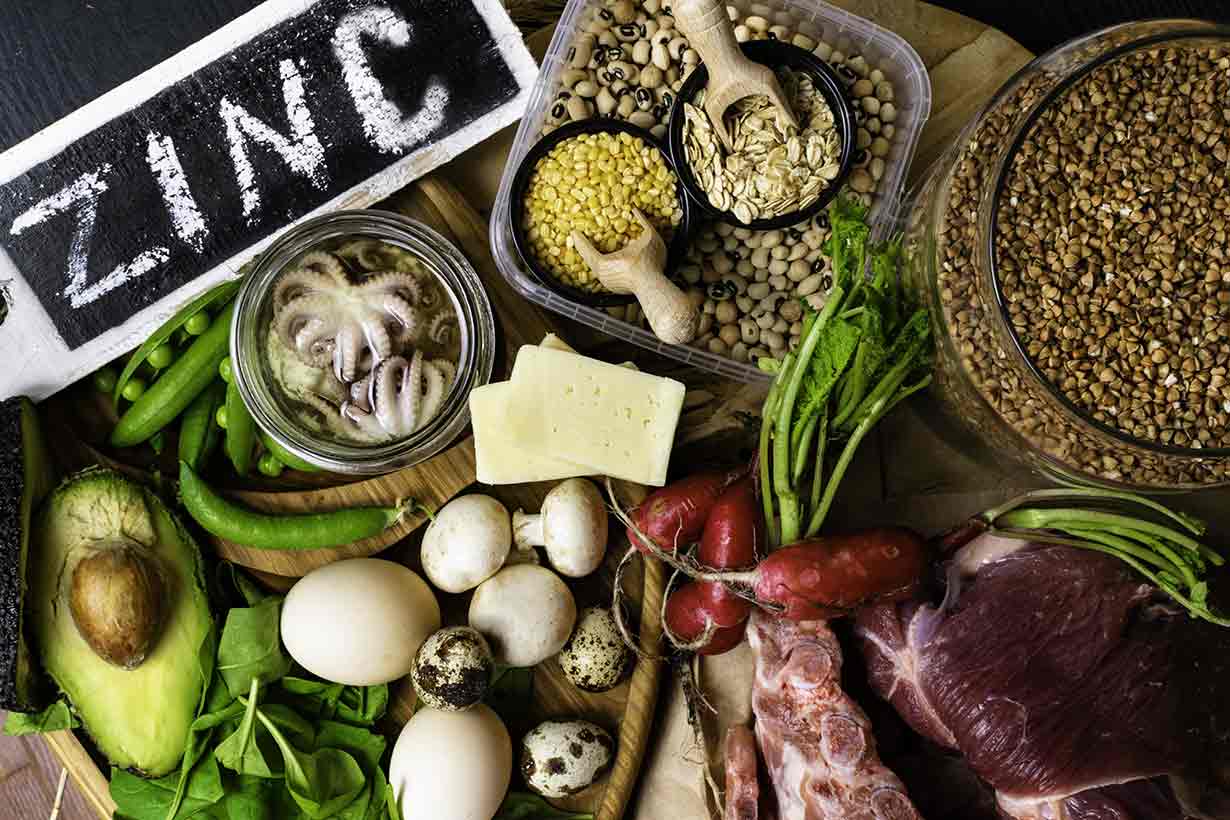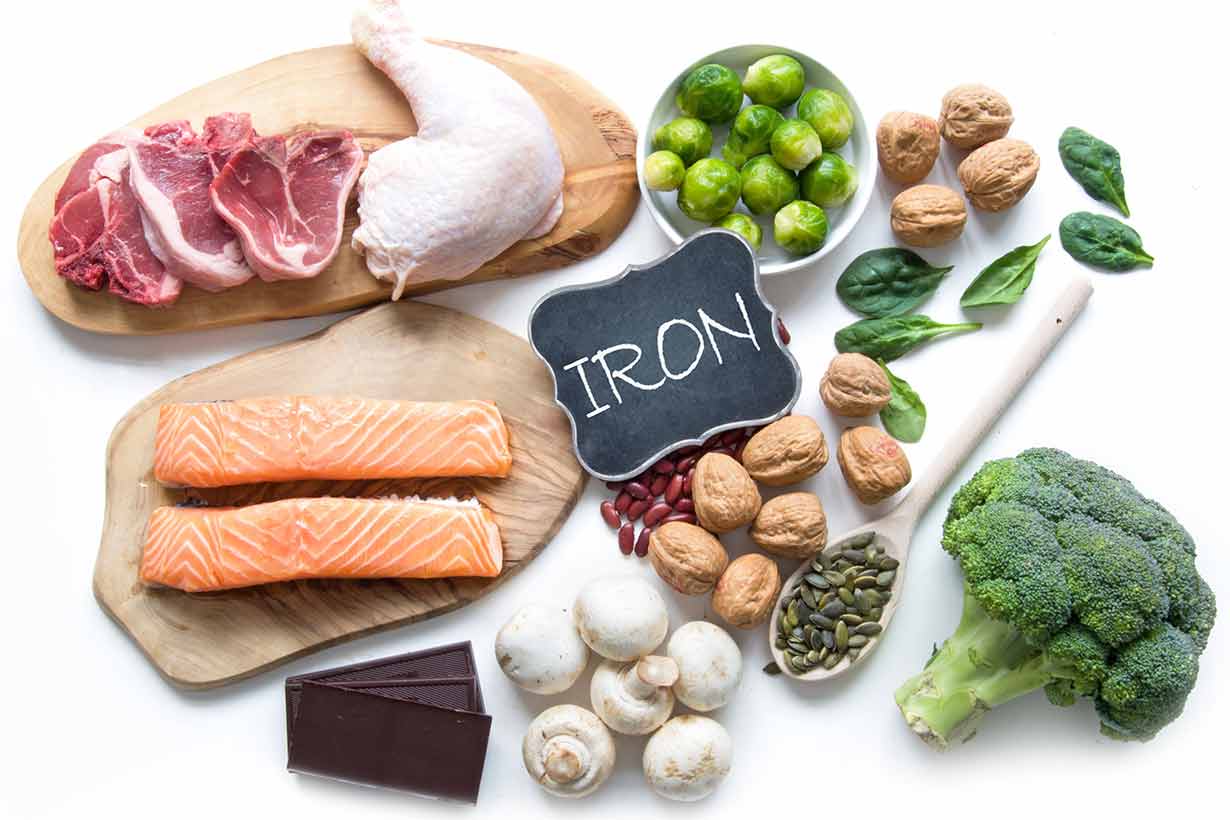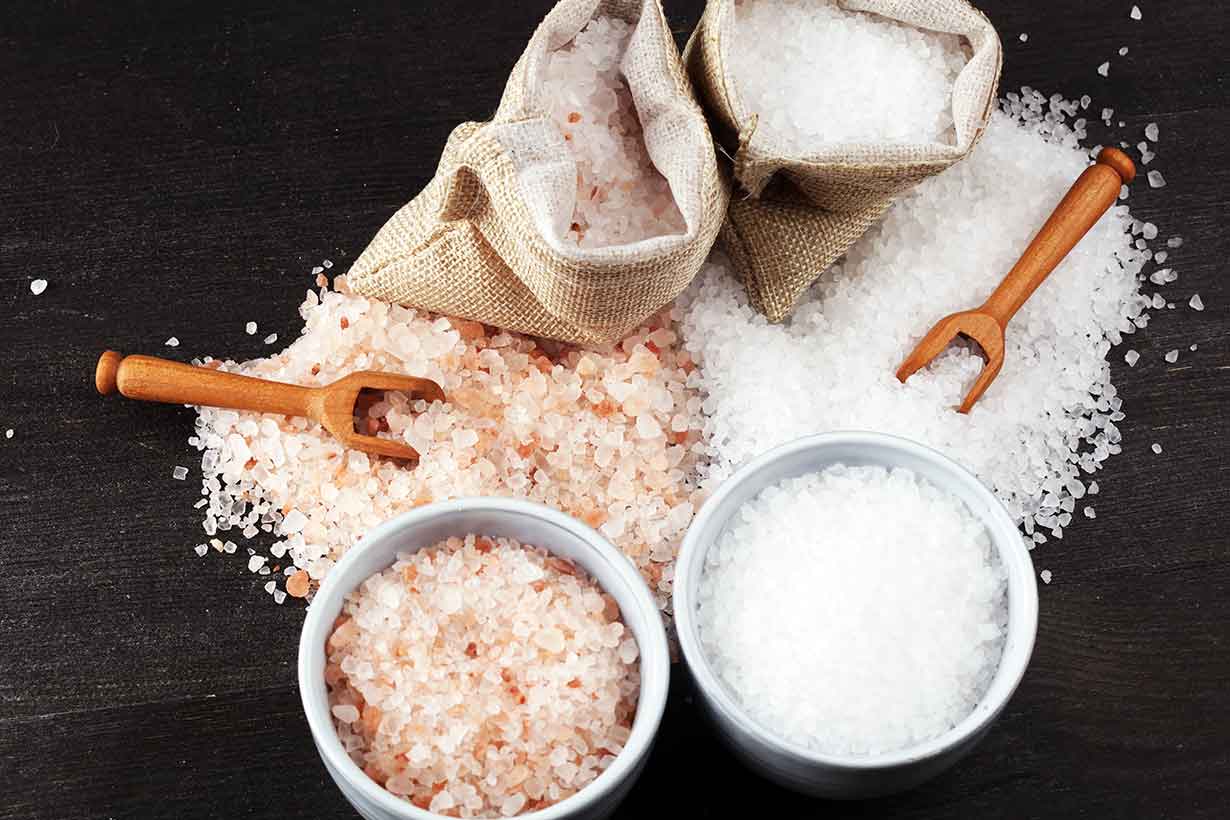Potassium is an essential mineral that we need to obtain from the foods we eat.
This article lists 30 foods high in potassium alongside the amount of the mineral each food contains per 100 grams and per typical serving.
What are the best dietary sources of potassium?
Let’s find out.
Why is Potassium Important?
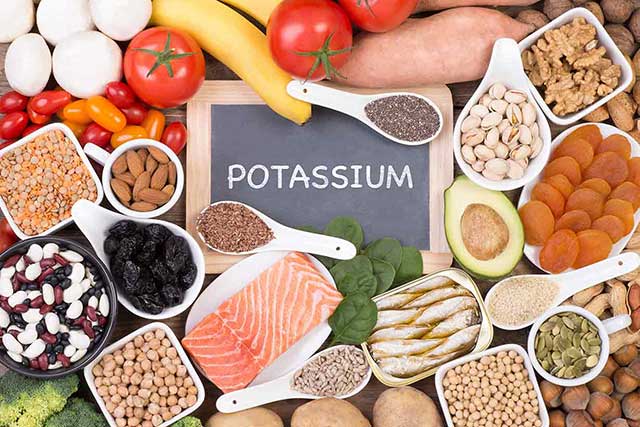
Potassium has numerous crucial functions within the body. Among these functions, potassium plays an important role in blood pressure regulation (alongside sodium), muscular contraction, and nerve transmission (1).
Generally speaking, increasing the intake of potassium and lowering sodium intake is likely to lead to lower blood pressure (2).
See here for more on the importance of potassium: potassium functions and benefits
Also, see this list of foods high in sodium for more relevant information.
Despite the importance of sufficient dietary potassium intake, hypokalemia (low serum potassium levels) is quite prevalent. According to the National Health and Examination Survey (NHANES), it was estimated that hypokalemia prevalence was 11% in the United States population in 2016 (3).
High potassium levels are present in foods such as leafy green vegetables, legumes, potatoes, pork, and seafood.
How Much Potassium Do We Need?
Adequate Intake Levels
The Food and Nutrition Board at the National Academies of Sciences, Engineering, and Medicine provides adequate intakes (AIs) for potassium.
Adequate Intakes (AIs) are set when there is insufficient data to make an evidence-based recommendation. The AIs are assumed to provide adequate potassium for the population.
The AIs depend on life stage and sex and are shown in the following table (4):
| Life Stage | Male | Female |
|---|---|---|
| <6 months old | 400 mg | 400 mg |
| 7-12 months | 860 mg | 860 mg |
| 1-3 years | 2,000 mg | 2,000 mg |
| 4-8 years | 2,300 mg | 2,300 mg |
| 9-13 years | 2,500 mg | 2,300 mg |
| 14-18 years | 3,000 mg | 2,300 mg |
| >19 years old | 3,400 mg | 2,600 mg |
| During pregnancy (age <18 years) | 2,600 mg | |
| During pregnancy (age >19 years) | 2,900 mg | |
| Lactation (<18 years) | 2,500 mg | |
| Lactation (>19 years) | 2,800 mg |
Daily Values (% DV)
The US Food and Drug Administration (FDA) sets a ‘daily value’ for potassium, which is a simple reference value for the amount we should consume. The ‘daily value’ (% DV) is based upon a typical 2000-calorie diet.
The daily value for potassium is 4,700 mg (5).
Foods High In Potassium
Here is a list of potassium-rich foods and the exact amount of potassium each food contains per serving and per 100 grams.
The source of nutritional data is the USDA FoodData Central database.
Additionally, daily values have been calculated by using USDA data and the FDA’s published daily values.
1) Adzuki beans, cooked
| Potassium per 100 grams | Potassium per 230-gram cup |
|---|---|
| 532 mg (11% DV) | 1220 mg (26% DV) |
A 230-gram cup of cooked adzuki beans provides 1220 mg of potassium, 26% of the daily value (6).
2) Avocado, raw
| Potassium per 100 grams | Potassium per 201-gram avocado |
|---|---|
| 485 mg (10% DV) | 975 mg (21% DV) |
A typical 201-gram avocado provides a rich source of potassium equal to 21% of the daily value (7).
3) Bamboo shoots, cooked
| Potassium per 100 grams | Potassium per 120-gram half cup |
|---|---|
| 533 mg (11% DV) | 640 mg (14% DV) |
Bamboo shoots are among the highest-potassium vegetables; a 120-gram half-cup serving offers 14% of the daily value (8).
4) Baobab powder
| Potassium per 100 grams | Potassium per oz (28.35g) serving |
|---|---|
| 2190 mg (47% DV) | 621 mg (13% DV) |
Baobab powder, the dried powder of the baobab fruit, offers a significant amount of potassium. Each ounce (28.35g) serving provides 13% of the daily value (9).
5) Beet greens, cooked
| Potassium per 100 grams | Potassium per 144g cup |
|---|---|
| 909 mg (19% DV) | 1310 mg (28% DV) |
Beet greens are among the most potassium-rich vegetables; a 144-gram cup serving offers 28% of the daily value (10).
6) Edamame, cooked
| Potassium per 100 grams | Potassium per 160g cup |
|---|---|
| 422 mg (9% DV) | 675 mg (14% DV) |
Like most soy products, edamame is an excellent source of potassium. A 160-gram cup of cooked edamame provides 14% of the daily value (11).
7) Grouper, cooked
| Potassium per 100 grams | Potassium per 202g fillet |
|---|---|
| 475 mg (10% DV) | 960 mg (20% DV) |
In general, fish is a rich source of potassium, and grouper is one of the best options. For example, a 202-gram cooked grouper fillet contains 20% of the daily value (12).
8) Guava
| Potassium per 100 grams | Potassium per 55-gram fruit |
|---|---|
| 417 mg (9% DV) | 229 mg (5% DV) |
Guava is a potassium-rich tropical fruit; one 55-gram fruit (without refuse) provides 5% of the daily value (13).
9) Kielbasa sausage
| Potassium per 100 grams | Potassium per 3-ounce (85g) serving |
|---|---|
| 306 mg (7% DV) | 260 mg (6% DV) |
A three-ounce (85-gram) serving of cooked kielbasa sausage offers 6% of the daily value for potassium (14).
10) Lima beans, cooked
| Potassium per 100 grams | Potassium per 188-gram cup |
|---|---|
| 508 mg (11% DV) | 955 mg (20% DV) |
Lima beans are one of the best legumes for potassium content; a 188-gram cup of cooked beans contains 20% of the daily value (15).
11) Mackerel, Atlantic, cooked
| Potassium per 100 grams | Potassium per 88-gram fillet |
|---|---|
| 401 mg (9% DV) | 353 mg (8% DV) |
Atlantic mackerel is one of the best seafood options for potassium; an 88-gram fillet contains around 8% of the daily value (16).
12) Milk, Skim
| Potassium per 100 grams | Potassium per 245g cup |
|---|---|
| 171 mg (4% DV) | 419 mg (9% DV) |
All milk is a good source of potassium, but skim milk offers the most. A 245-gram cup provides 9% of the daily value (17).
13) Peanuts, Spanish
| Potassium per 100 grams | Potassium per oz (28.35g) |
|---|---|
| 776 mg (17% DV) | 220 mg (5% DV) |
Spanish peanuts contain 5% of potassium’s daily value per ounce (28.35g) serving (18).
14) Plantains, green cooked
| Potassium per 100 grams | Potassium per 118-gram cup |
|---|---|
| 482 mg (10% DV) | 569 mg (12% DV) |
Cooked green plantains contain high levels of potassium; a 118-gram cup of fried plantains provides 12% of the daily value (19).
15) Potato, Russet, cooked
| Potassium per 100 grams | Potassium per large (299g) potato |
|---|---|
| 550 mg (12% DV) | 1640 mg (35% DV) |
Potatoes are one of the best dietary sources of potassium. A large cooked Russet potato with skin provides 35% of the daily value (20).
16) Potato flour
| Potassium per 100 grams | Potassium per 80-gram half cup |
|---|---|
| 1000 mg (21% DV) | 800 mg (17% DV) |
Like whole potatoes, potato flour is a rich potassium source. For example, an 80-gram half cup of potato flour offers 17% of the daily value (21).
17) Raisins
| Potassium per 100 grams | Potassium per oz (28.35g) |
|---|---|
| 825 mg (18% DV) | 227 mg (5% DV) |
Raisins (dried grapes) are a concentrated source of nutrients in grapes and contain a good amount of potassium. An ounce (28.35g) serving offers 5% of the daily value (22).
18) Red kidney beans, cooked
| Potassium per 100 grams | Potassium per 177g cup |
|---|---|
| 403 mg (9% DV) | 713 mg (15% DV) |
A 177-gram cup serving of cooked red kidney beans provides 15% of potassium’s daily value (23).
19) Salami, pork-based
| Potassium per 100 grams | Potassium per ounce (28.35g) |
|---|---|
| 340 mg (7% DV) | 95.2 mg (2% DV) |
Salami is a good source of potassium, but pork-based products offer the most. An ounce (28.35g) of salami typically contains 2% of the daily value (24).
20) Salmon, Atlantic, wild, cooked
| Potassium per 100 grams | Potassium per half-fillet (154g) |
|---|---|
| 628 mg (13% DV) | 967 mg (21% DV) |
All salmon have high levels of potassium, but wild Atlantic salmon contains the most. A 154-gram half-fillet provides 21% of the daily value (25).
21) Snapper, cooked
| Potassium per 100 grams | Potassium per 170g fillet |
|---|---|
| 522 mg (11% DV) | 887 mg (19% DV) |
Snapper is another potassium-rich fish option; a 170-gram fillet provides 19% of the daily value (26).
22) Soybeans, mature, cooked
| Potassium per 100 grams | Potassium per 172g cup |
|---|---|
| 515 mg (11% DV) | 886 mg (19% DV) |
Cooked soybeans offer a high potassium level; 19% of the daily value per 172-gram cup (27).
23) Soy flour, defatted
| Potassium per 100 grams | Potassium per 6.6g tablespoon |
|---|---|
| 2380 mg (51% DV) | 157 mg (3% DV) |
Since it is made from pure soybeans, soy flour contains a good amount of potassium.
Defatted soy flour has lower fat levels and thus higher amounts of minerals gram-for-gram.
Just a 6.6-gram tablespoon of defatted soy flour contains 3% of the daily value for potassium (28).
24) Sun-dried tomatoes
| Potassium per 100 grams | Potassium per 54-gram cup |
|---|---|
| 3430 mg (73% DV) | 1850 mg (39% DV) |
Dried foods naturally have a lower water content gram-for-gram, thus a higher nutrient level. For instance, a 54-gram cup of sun-dried tomatoes provides 39% of potassium’s daily value (29).
25) Sweet potatoes, cooked
| Potassium per 100 grams | Potassium per large (180g) potato |
|---|---|
| 475 mg (10% DV) | 855 mg (18% DV) |
Similar to regular potatoes, sweet potatoes offer a concentrated source of potassium. A large 180-gram sweet potato provides 18% of the daily value (30).
26) Swiss chard, cooked
| Potassium per 100 grams | Potassium per 175g cup serving |
|---|---|
| 549 mg (12% DV) | 961 mg (20% DV) |
Swiss chard is another leafy green that contains high levels of potassium. A 175-gram cup serving supplies 20% of the daily value (31).
27) Tomato puree
| Potassium per 100 grams | Potassium per half-cup (125g) serving |
|---|---|
| 439 mg (9% DV) | 550 mg (12% DV) |
Using tomato puree in recipes is a simple way to increase the potassium content of food. In this regard, each half-cup (125-gram) serving of tomato puree provides 12% of the daily value (32).
28) Tuna, yellowfin, cooked
| Potassium per 100 grams | Potassium per 3oz (85g) |
|---|---|
| 527 mg (11% DV) | 448 mg (10% DV) |
All tuna provides potassium, but yellowfin has the highest levels. A three-ounce (85-gram) serving of yellowfin tuna has 10% of the daily value (33).
29) Wheat germ, toasted
| Potassium per 100 grams | Potassium per oz (28.35g) |
|---|---|
| 947 mg (20% DV) | 268 mg (6% DV) |
Wheat germ is a rich source of nutrients, including potassium. An ounce (28.35g) of toasted wheat germ provides 6% of the daily value (34).
30) Yam, cooked
| Potassium per 100 grams | Potassium per 136g cup |
|---|---|
| 670 mg (14% DV) | 911 mg (19% DV) |
The yam is another potassium-rich tuber. A 136-gram cup of cooked yam offers 19% of the daily value (35).
Herbs and Spices
Additionally, it is worth noting that dried herbs and spices offer significant potassium concentrations.
However, since we use these seasonings in such minimal quantities, the actual realistic amounts of potassium they contribute are low.
Using herbs and spices in our cooking is an easy way to increase our potassium intake slightly.
For instance, a teaspoon of dried herbs and spices will offer up to 0.5% of the daily value for potassium.
Here are some good options:
- Parsley
- Coriander
- Tarragon
- Basil
- Cayenne pepper
Which Foods Provide the Most Potassium Per Serving?
This table provides a simple comparison of the foods with the highest potassium content per typical serving.
| Rank | Food Name | Serving Size | Potassium Content |
|---|---|---|---|
| 1 | Sun-dried tomatoes | 54g cup | 1850 mg (39% DV) |
| 2 | Potato, Russet, cooked | Large (299g) potato | 1640 mg (35% DV) |
| 3 | Beet greens, cooked | 144g cup | 1310 mg (28% DV) |
| 4 | Adzuki beans, cooked | 230g cup | 1220 mg (26% DV) |
| 5 | Avocado, raw | 201g avocado | 975 mg (21% DV) |
| 6 | Salmon, Atlantic, wild, cooked | Half fillet (154g) | 967 mg (21% DV) |
| 7 | Swiss chard, cooked | 175g cup | 961 mg (20% DV) |
| 8 | Grouper, cooked | 202g fillet | 960 mg (20% DV) |
| 9 | Lima beans, cooked | 188g cup | 955 mg (20% DV) |
| 10 | Yam, cooked | 136g cup | 911 mg (19% DV) |
| 11 | Snapper, cooked | 170g fillet | 887 mg (19% DV) |
| 12 | Soybeans, cooked | 172g cup | 886 mg (19% DV) |
| 13 | Sweet potato, cooked | 180g potato | 855 mg (18% DV) |
| 14 | Potato flour | 80g half-cup | 800 mg (17% DV) |
| 15 | Red kidney beans, cooked | 177g cup | 713 mg (15% DV) |
| 16 | Edamame, cooked | 160g cup | 675 mg (14% DV) |
| 17 | Bamboo shoots, cooked | 120g half-cup | 640 mg (14% DV) |
| 18 | Baobab powder | 1oz (28.35g) | 621 mg (13% DV) |
| 19 | Plantains, green, cooked | 118g cup | 569 mg (12% DV) |
| 20 | Tomato puree | 125g half-cup | 550 mg (12% DV) |
| 21 | Tuna, yellowfin, cooked | 3oz (85g) | 448 mg (10% DV) |
| 22 | Milk, skim | 245g cup | 419 mg (9% DV) |
| 23 | Mackerel, Atlantic, cooked | 88g fillet | 353 mg (8% DV) |
| 24 | Wheat germ, toasted | 1oz (28.35g) | 260 mg (6% DV) |
| 25 | Kielbasa sausage, cooked | 3oz (85g) | 260 mg (6% DV) |
| 26 | Guava | 55g fruit | 229 mg (5% DV) |
| 27 | Raisins | 1oz (28.35g) | 227 mg (5% DV) |
| 28 | Peanuts, Spanish | 1oz (28.35g) | 220 mg (5% DV) |
| 29 | Soy flour, defatted | 6.6g tablespoon | 157 mg (3% DV) |
| 30 | Salami, pork-based | 1oz (28.35g) | 95 mg (2% DV) |
Final Thoughts
As this article shows, many foods are high in potassium from diverse food groups.
Consuming seafood, legumes, and fruit and vegetables like avocados, bananas, and leafy greens are some of the best ways to get more of the mineral.
For more on mineral-rich foods, see this guide to the top food sources of magnesium.

